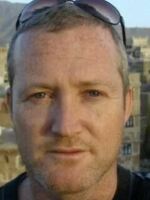Updated December 05, 2024 at 15:58 PM ET
Syrian opposition militias have stormed Hama city in central Syria, in a sweeping offensive that threatens the stability of President Bashar Assad's regime.
In 13 years of civil war, in which other territory was lost and regained, the government always held Hama. During Syria's popular uprisings in 2011, when tens of thousands of Hama residents took to the streets to call for the fall of Assad, the regime was able to crush the dissent.
Now, it has lost control of the city in a rebel assault that lasted just four days.
The Syrian ministry of defense said in a written statement that government forces have redeployed to "outside the city" and the Syrian military had lost large numbers of troops trying to defend Hama.
Abu Mohammed al-Golani, the leader of Hayat Tahrir al-Sham, an Islamist militia and the main group in the rebel offensive, said in a video address that his forces entered Hama "to cleanse that wound that has persisted in Syria for forty years," referring to the rule of the Assad family.
The rebel forces' entrance into Hama comes less than a week after they seized the historic merchant city of Aleppo, Syria's second-most populous center.
For so long a symbol of the Assad family's prowess, Hama's capture exposes just how frail the regime has become in its ability to keep control of restive populations.
In 1982, President Hafez Assad, father of the current president, crushed a rebellion in Hama by razing the city in a massacre that killed many thousands of people (the true toll is not known). It is perhaps still the bloodiest single assault by an Arab leader against his people.
In 2011, during massive anti-government protests in Hama, the regime put tanks on the streets and was ultimately able to suppress the dissent.
Now, with government troops in retreat, the Syrian flag used by the opposition — a horizontal triband of green, white and black with three red stars in the center — is flying in the middle of the city.
Videos and photos shared online show groups of young men standing at a central roundabout in Hama cheering the armed rebels as they speed around in cars still caked in the mud they used to camouflage their advance across desert terrain to the city.
After years in which the Syrian civil war had reached a kind of stasis of mostly frozen frontlines — and in which the regime was seen as having largely won back control of most of Syria — the gains in the past week's lightning assault seem to have shocked even the rebels themselves, with senior opposition officials telling NPR they hadn't expected such quick victories.
But viewed from the Syrian capital, Damascus, this collapse of regime lines was much more predictable. "I'm surprised it took this long," says one Syrian resident, speaking about the four-day Hama offensive. He asked not to be named for fear that speaking with Western media could cause him problems with the regime's feared intelligence agencies.
"It's over," another Damascus resident, a businessman with good connections inside the regime's elite, told NPR. He asked not to be named for fear of upsetting his government contacts. "The regime is rotten. You know, when there is absolute corruption in a society it cannot survive."
Sanctions and years of conflict have left Syria's economy in tatters, with many Syrians in regime-held parts of the country suffering greater economic hardship now than even during the height of the conflict before 2019. To survive, analysts say, the regime has increasingly had to rely on corruption and funds earned through the production and export of the highly addictive drug Captagon, an amphetamine-like substance.
"The regime's military apparatus has stagnated in recent years, decaying from within and fragmenting on the outside," writes Charles Lister, the director of the Syria program at the Middle East Institute, in Foreign Policy.
The Syrian businessman from Damascus told NPR nowadays he sometimes "sees tanks abandoned on the street" that have run out of fuel.

By comparison, opposition militias have developed into a significant fighting force. A video posted online by the "Military Operations Department," the centralized command for the rebel advance, shows rows of pickup trucks full of heavily armed men in black masks and military uniform. More videos show infantry units and artillery, even armed drones.
Taking Hama now will put the opposition militias in position to push on to Homs, 24 miles south. And this could cut Damascus off from the coastal region that has long been a regime stronghold, and where Russia, Assad's ally, controls a naval port and airbase.
"Assad now cannot afford to lose anything else. The big battle is the one coming against Homs. If Homs falls, we are talking of a potential change of regime," Jihad Yazigi, editor of the Syria Report newsletter, told Reuters.
While Hama is majority-Sunni Muslim, the surrounding province is more diverse and home to Alawites, Ismailis and Christians.
Hayat Tahrir al-Sham, listed by the U.S. and the United Nations as a terrorist organization, has past links to al-Qaida. It has since cut ties with the group and has sought to remake itself, abandoning any global ambitions and practicing a more moderate approach than hardline Islamist groups, in the way it governed Idlib, the rebel enclave close to Syria's border with Turkey, in recent years.
World leaders have been calling for deescalation in Syria, with U.N. Secretary General António Guterres urging a ceasefire and the protection of civilians.
In his victory speech after storming Hama, HTS leader Golani called on his fighters to treat this as a "conquest full of mercy and kindness." The group has repeatedly signaled that it means no harm to minorities and it has urged Alawites — those belonging to the same sect as the Assad family — to distance themselves from the regime.
After taking Aleppo, HTS was careful to show that it would continue to allow Christians in the city to practice their religious beliefs.
But these are early days. And while HTS leaders may have decided this gives their revolution the best chance of success, it remains unclear whether they can enforce this discipline in their ranks, after such a long, bloody and rancorous civil war. Both rebel forces and regime militias have committed sectarian massacres in this conflict, in some cases slaughtering civilians in their homes.
Earlier this week, when NPR reached two Alawite sisters in Hama via WhatsApp, their bags were packed by their door, as they said others on their street were already loading what possessions they could fit in their cars and fleeing.
Copyright 2024 NPR





